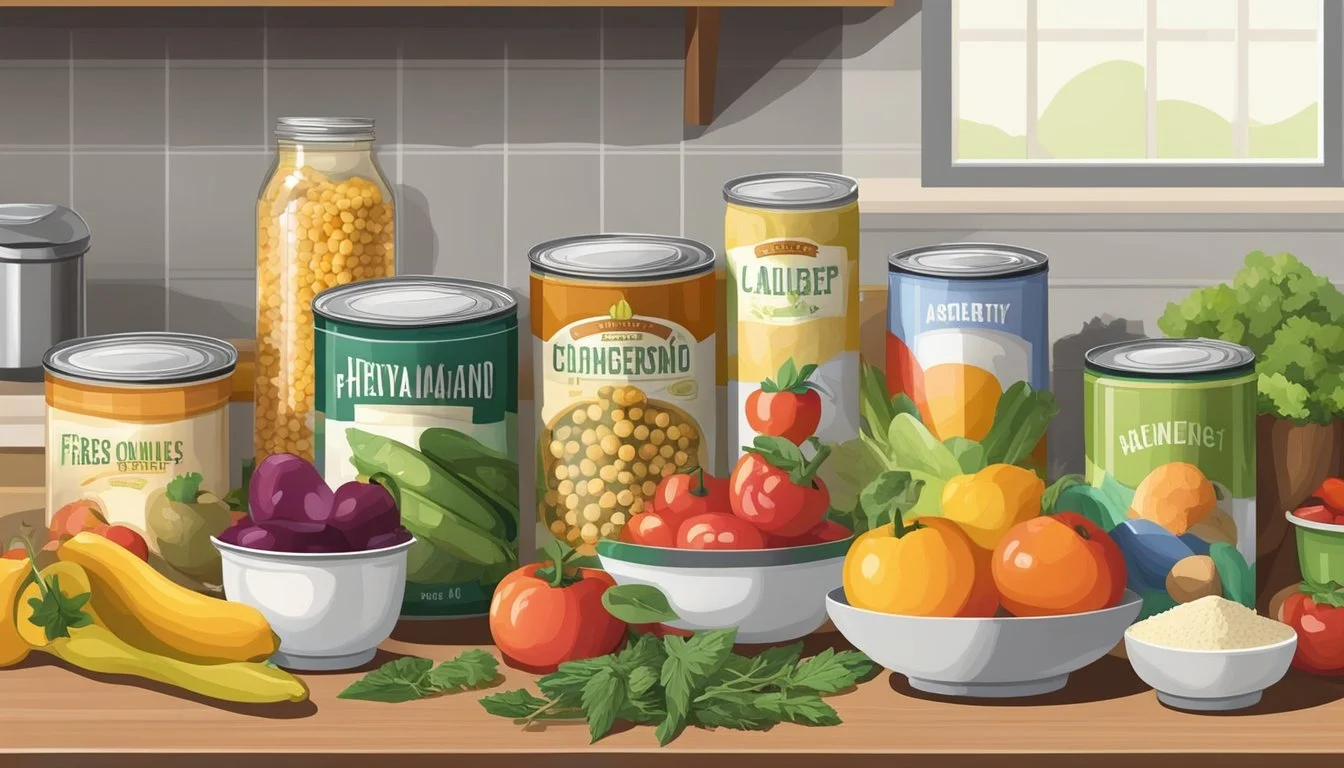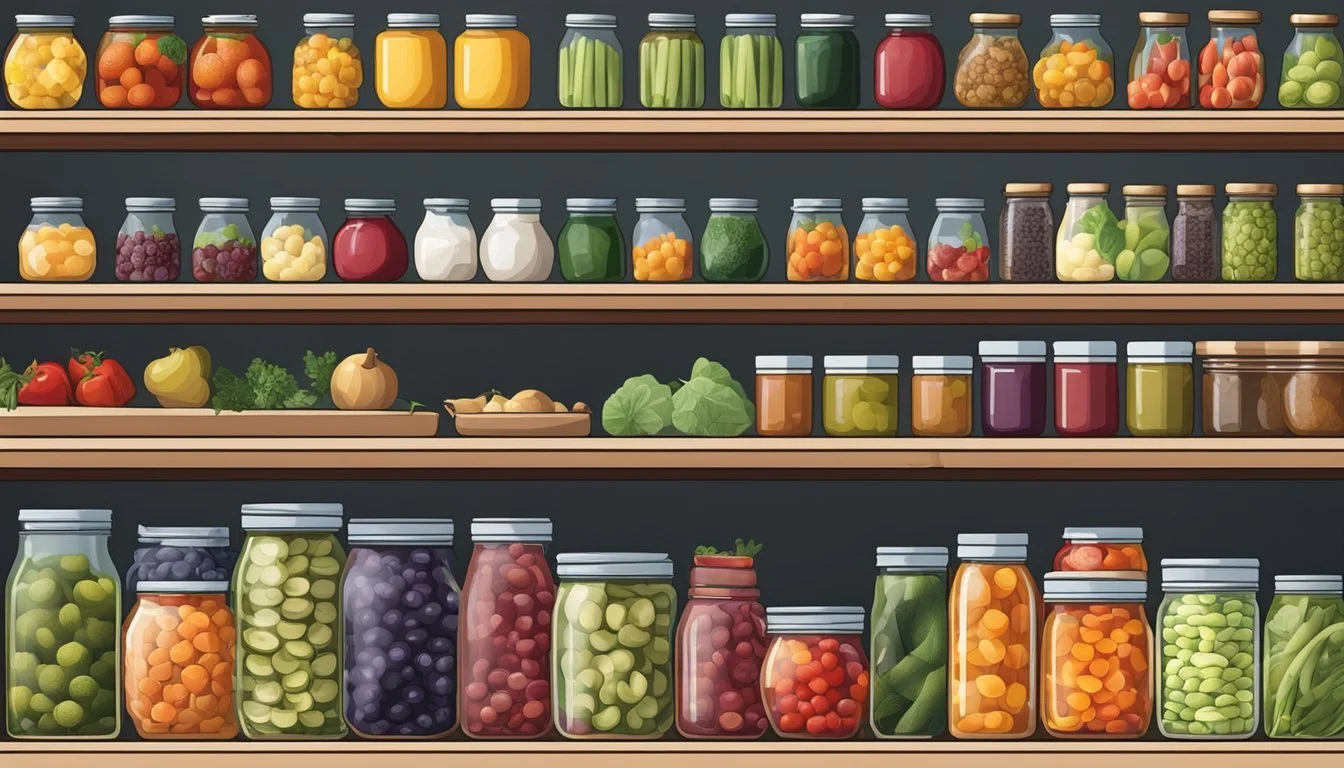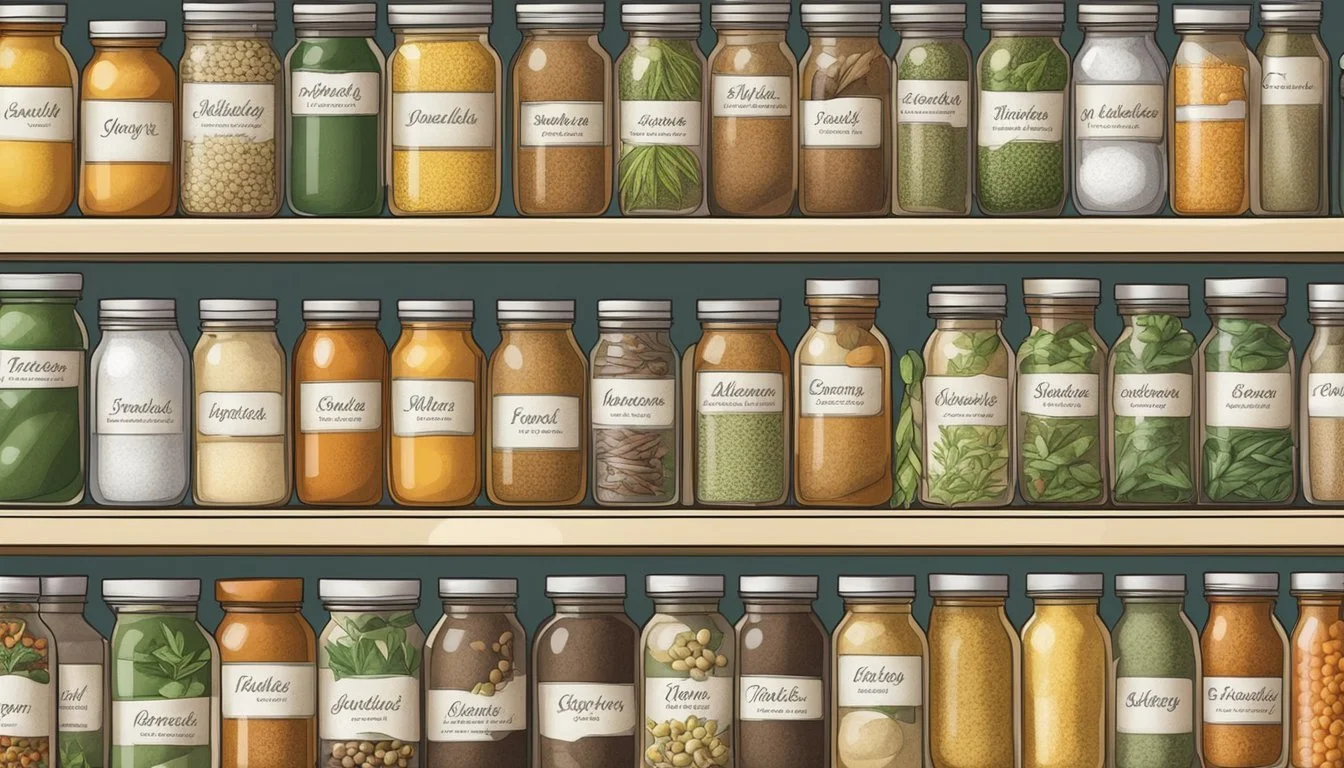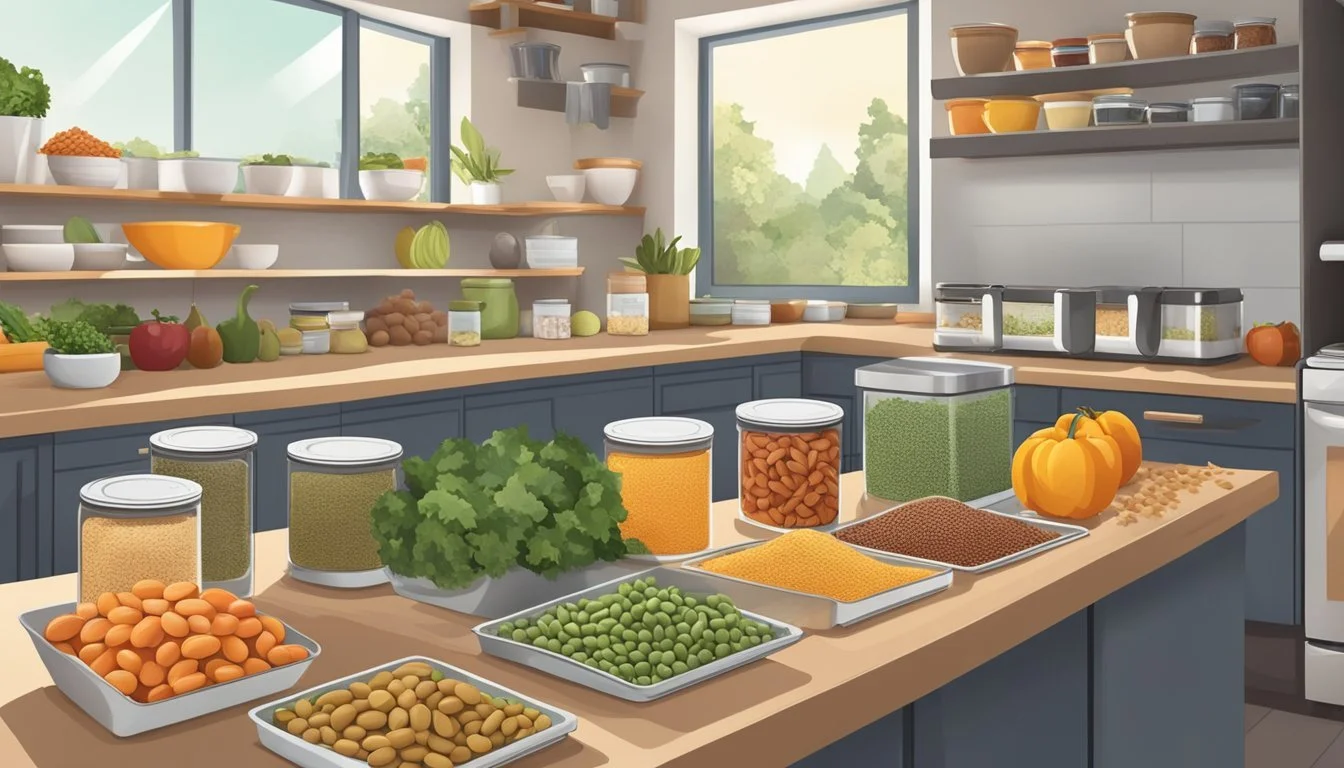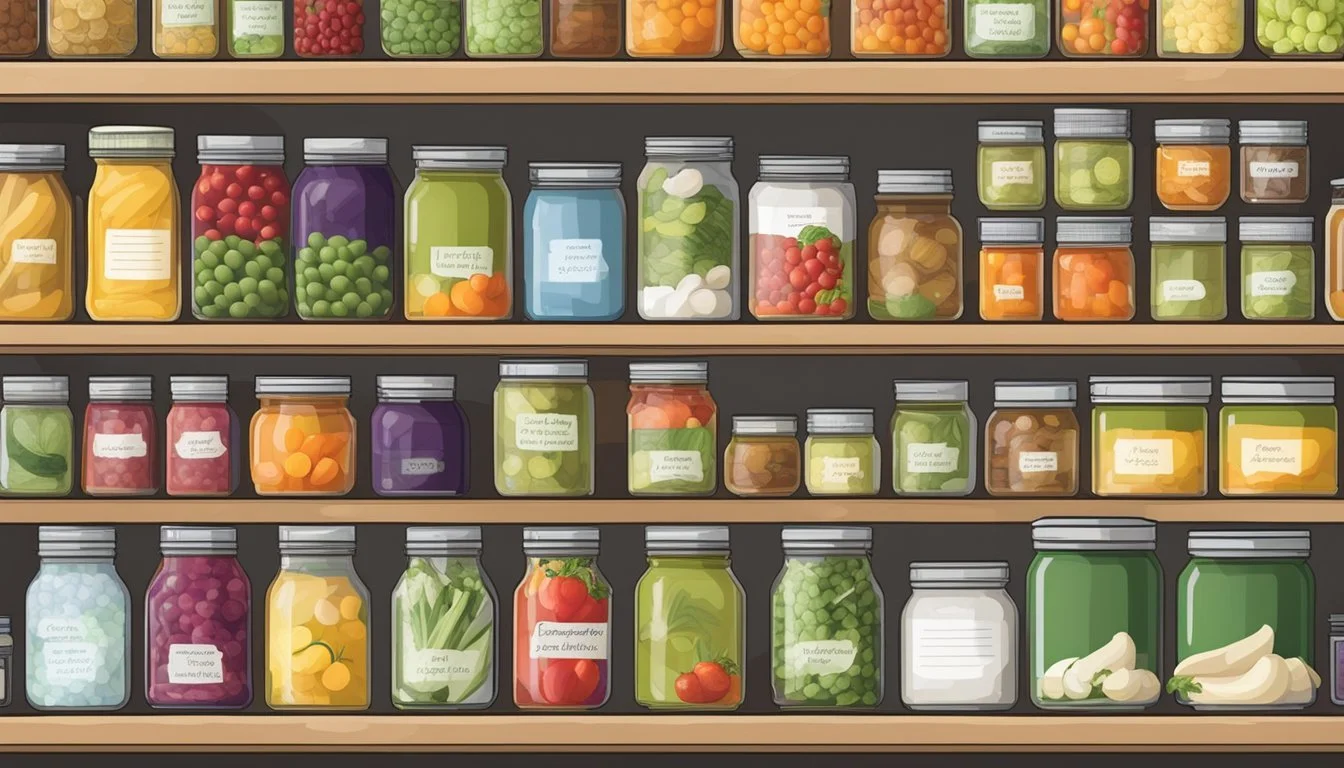Shelf-Stable Ingredient Swaps for Fresh Produce
Essential Alternatives for Your Pantry
In the realm of cooking, the use of fresh produce is often celebrated for its ability to imbue dishes with vibrant flavors and provide optimal nutritional benefits. However, various circumstances can limit access to fresh fruits and vegetables, necessitating the exploration of shelf-stable ingredients as substitutes. These pantry staples not only ensure that meals can still be healthful and comforting but also add a dimension of convenience and longevity to one's food supplies.
Shelf-stable ingredients allow for the adaptation of recipes originally reliant on fresh produce without significant compromise to taste or nutrition. Ingredients such as canned tomatoes, roasted red peppers, and coconut milk can be utilized to mimic the texture and flavor profiles of their fresh counterparts. For instance, robust tomato soup from shelf-stable packages can serve as a foundation in recipes calling for fresh tomatoes, offering both the desired taste and necessary health benefits with a much longer shelf life.
Utilizing these non-perishable items also affords a sense of reliability in meal planning. From the creamy richness of shelf-stable gnocchi combined with mushrooms to the versatility of canned legumes and fruits, there's a wealth of opportunities to create wholesome, satisfying meals. This approach not only maintains a level of nutritional integrity but also caters to the need for comforting and familiar food experiences in times when fresh produce might not be an option. Through intelligent swaps and a little culinary creativity, healthy and appealing meals are always within reach.
Understanding Shelf-Stable Ingredients
Shelf-stable ingredients are essential components in maintaining a well-stocked pantry, known for their longevity without refrigeration and their ability to replace fresh produce when needed.
Defining Shelf-Stability
Shelf-stable ingredients are food items that can be safely stored at room temperature for an extended period of time. They have undergone specific processing methods such as drying, canning, or aseptic packaging to ensure their longevity. These ingredients do not require refrigeration until opened and include products like canned vegetables, grains, dried pasta, and UHT (ultra-high temperature) processed dairy.
The Benefits of Pantry Staples
Pantry staples offer numerous advantages:
Long shelf life: They last for months or even years, reducing the need for frequent grocery trips.
Convenience: Ready-to-eat or requiring minimal preparation, they save time in meal preparation.
Versatility: They can be used in a wide range of recipes.
Moreover, maintaining a pantry full of staples ensures that nutritious meals can be prepared even when access to fresh produce is limited.
Nutritional Comparison with Fresh Produce
While fresh veggies are known for their high levels of vitamins and minerals, shelf-stable ingredients can still offer significant nutritional value. The key is to select options that are low in sodium and free of added sugars or unhealthy fats. Here's a brief comparison:
Nutrient Fresh Produce Shelf-Stable Ingredients Vitamins Typically higher levels Some loss due to processing, but often fortified with additional nutrients Minerals Varied based on type Comparable levels, dependent on processing and fortification Fiber Often higher in fresh Present in whole grains and legumes Convenience Requires preparation Ready-to-eat or require minimal preparation
While shelf-stable items may not always match the exact nutritional profile of their fresh counterparts, they remain a crucial part of a balanced diet, especially when fresh options are scarce.
Protein Alternatives to Fresh Meat and Fish
When considering alternatives to fresh meat and fish, one should focus on protein content and ease of storage. Shelf-stable options such as canned beans and legumes, nuts and seeds, and canned fish provide protein and other nutrients with a longer shelf life.
Canned Beans and Legumes
Canned beans and legumes offer a convenient protein source and can easily replace meat in many recipes. Not only are they rich in protein, but they also provide dietary fiber that aids digestion.
Chickpeas: With about 7.25 grams of protein per half-cup serving, chickpeas are versatile and can be used in salads, soups, and stews.
Black Beans: A half-cup of cooked black beans contains around 7.5 grams of protein. They work well in Mexican-inspired dishes and as fillers in vegetarian burgers.
Nuts and Seeds as Protein Sources
Nuts and seeds are nutritious alternatives to fresh animal proteins, offering essential fatty acids alongside their protein content.
Almonds: Consuming a quarter-cup of almonds grants approximately 7 grams of protein. They're excellent in granola or as a topping for salads and yogurt.
Sunflower Seeds: A simple quarter-cup serving supplies close to 6.5 grams of protein, perfect for mixing into bread or sprinkling over breakfast bowls.
Utilizing Tuna and Other Canned Fish
Canned fish such as tuna (What wine goes well with tuna?) stands out as a staple replacement for fresh fish, with a high protein content and the benefit of omega-3 fatty acids.
Tuna: A can of tuna in water provides about 22 grams of protein and can be combined with a variety of ingredients for salads, sandwiches, and pasta dishes.
Salmon: (What wine goes well with salmon?) Canned salmon is another excellent source, with around 17 grams of protein per half-cup serving, suitable for making fish cakes or adding to grain bowls.
These substitutes not only suffice as nutritious alternatives but also present the flexibility of long-term storage, making them a strategic option for maintaining a balanced diet when fresh produce isn't accessible.
Carbohydrate Swaps for Fresh Staples
Carbohydrates are critical for energy, and when fresh produce isn't an option, pantry carbs take center stage. These staple swaps are nutritional powerhouses that ensure variety and satisfaction in your diet.
Rice and Pasta: The Pantry Essentials
Pantry staples like rice and pasta provide versatile carbohydrate options when fresh produce is unavailable. Rice can be a side dish, a base for stir-fries, or a component of soups and salads.
White rice stores well and cooks quickly, making it a convenient choice.
For a fiber-rich alternative, one might opt for brown rice, which has a longer cooking time but offers additional nutritional benefits.
Pasta serves as another foundational carb that is shelf-stable and can create numerous dishes.
Whole grain pasta holds more fiber and nutrients compared to its refined counterpart.
With a variety of shapes, pasta can be used in soups, casseroles, or served with a range of sauces.
Bread and Flour Alternatives
When fresh bread and flour are scarce, consider the following alternatives for their shelf-stability and adaptability:
Crackers: A crisp alternative that pairs well with cheese, spreads, and can serve as a base for appetizers.
Pita bread: Often packaged for a longer shelf life, pita can substitute for bread in sandwiches or be toasted into chips.
For baking needs, flour can be swapped with:
Almond or coconut flour: These are low-carb options that add a unique flavor profile and are suitable for specific dietary needs.
Creative Uses of Quinoa and Oats
Quinoa and oats are carbohydrate sources that offer more than just energy; they come packed with protein and fiber as well.
Quinoa:
Can replace rice in most recipes and is gluten-free.
Serves as an excellent base for salads, a supplement in baking, or as a breakfast cereal substitute.
Oats:
Beyond traditional oatmeal, they can be used in homemade granola bars or as a binder in meatballs and veggie patties.
Are valuable in baking, offering texture and moisture to goods like cookies and muffins.
Fruit and Vegetable Replacements
In this section, the focus is on identifying effective substitutes for fresh fruits and vegetables. These alternatives ensure a varied diet even when fresh produce is not available. Discover various frozen, canned, and dried options that maintain nutritional value and flavor.
Using Frozen Fruits and Vegetables
Frozen fruits and vegetables are excellent replacements for fresh produce. The freezing process preserves the nutrients, flavor, and texture of the produce. For example:
Green Peas and Corn: They can be directly substituted in recipes that call for fresh versions.
Berries: Frozen berries work well in smoothies or baked goods and have a similar nutrient profile to fresh berries.
Freezing fruits and vegetables at peak ripeness means they can sometimes have better taste and nutritional value compared to off-season fresh options.
Canned and Dried Fruits
Canned and dried fruits (What wine goes well with dried fruits?) can be especially handy:
Pineapple: Canned pineapple is a good substitute for fresh in both sweet and savory dishes.
Applesauce: Can replace oil in baking recipes and provide a sweet flavor.
Dried Fruit: Such as raisins, dates, and dried apricots, are concentrated sources of energy and sweetness and are ideal for snacking, cereals, and baking.
When using canned fruit, opt for those canned in juice rather than heavy syrup to reduce added sugars.
Dried Fruit Uses Raisins Oatmeal, cookies, salads. Dates Natural sweetener, energy bars, desserts. Dried Pears Snacks, compotes, baked goods.
Tomato Paste and Canned Vegetables
Tomato paste is a concentrated source of tomato flavor and can be used in sauces and stews:
Tomatoes: Using tomato paste in recipes can impart a rich, cooked tomato flavor that is comparable to fresh tomatoes.
Canned vegetables are practical and have a long shelf life:
Canned Veggies: Select low-sodium options when possible and use them in recipes like soups, stews, and casseroles.
Remember to drain and rinse canned vegetables to reduce the sodium content, which can be significantly higher than in fresh vegetables.
Dairy and Egg Substitutes
When considering shelf-stable alternatives to dairy and egg products, one can find a variety of choices that can substitute these ingredients in cooking and baking without sacrificing too much on taste or texture.
Cheese Alternatives
Nutritional Yeast: A flaky or powdery yeast that imparts a nutty, cheesy, and savory flavor, making it a good substitute for cheese flavor in many recipes, especially suitable for sprinkling over dishes as one would with grated parmesan.
Vegan Cheese: There are many shelf-stable vegan cheeses made from a variety of plants such as nuts, soy, and root vegetables. They can be found in different forms, from shreds to slices, and can melt or spread similarly to traditional cheese.
Shelf-Stable Milk and Yogurt
Coconut Milk: From the can, it serves as a rich, creamy alternative that can replace dairy milk and cream in sauces, soups, and baking recipes.
Milk Type Best Used For Coconut Milk Curries, Desserts Soy Milk General Cooking, Baking Rice Milk Lighter Sauces and Soups Almond Milk Cereal, Smoothies
Shelf-Stable Yogurt: Dairy-free yogurts made from almond, coconut, or soy, are fermented and thickened to resemble the consistency and tang of traditional yogurt, suitable to use in smoothies, dressings, or as egg substitutes in baking.
Dairy-Free Yogurt: It can be substituted for eggs in baking; typically, 1/4 cup of yogurt can replace one egg, effective for keeping baked goods moist and binding ingredients together.
Herbs, Spices, and Flavor Enhancers
When fresh produce is not an option, shelf-stable herbs, spices, and condiments can offer a resurgence of flavor to meals without sacrificing taste. They are pivotal in transforming simple dishes into flavorful delights.
Dried Herbs and Spice Blends
Dried Herbs: The use of dried herbs such as rosemary, oregano, and thyme offers a concentrated flavor which is stronger than their fresh counterparts. They should be added early in the cooking process to allow their flavors to infuse the dish.
Storage Tip: Store in a cool, dry place away from sunlight.
Shelf Life: Typically, ground spices retain their best quality for around six months to a year, while whole spices may last longer.
Spice Blends: Premixed spice blends can also be a time-saver, providing complex flavor profiles with a single addition. Prime examples include curry powder, Italian seasoning, or Cajun spice mix.
Usage: A perfect addition to marinades, rubs, or as a final seasoning touch.
DIY Tip: Create custom blends to cater to personal tastes or dietary needs.
Vinegars, Oils, and Condiments
Vinegars: Vinegar can brighten dishes with acidity. Varieties like balsamic, apple cider, and rice vinegar each contribute a unique essence.
Uses: Excellent for dressings, marinades, and enhancing the flavors of sauces.
Oils: Quality oils such as olive oil and coconut oil add their own characteristic tastes. Olive oil delivers a fruitiness while coconut oil brings a subtle tropical hint.
Health Note: These oils provide healthier fat alternatives and can be used for sautéing, baking, or as a dressing base.
Condiments: Staple condiments such as mayonnaise, mustard, and soy sauce expand the flavor palette. They provide creaminess, spice, and umami, respectively.
Garlic and Onion: Available in powder form, both add depth and are considered the backbone of savory flavoring.
Application: Ideal for quickly enhancing the taste of dips, spreads, and sauces.
This section illustrates the importance of shelf-stable ingredients like herbs, spices, vinegar, and oils, underlining their role in maintaining deliciousness in the absence of fresh produce. Their proper usage and storage ensure the longevity of these ingredients, making them reliable staples in any kitchen.
Creating Balanced Shelf-Stable Meals
The drive behind creating balanced shelf-stable meals is ensuring nutrition isn't compromised even when fresh produce isn't available. With a judicious selection of shelf-stable ingredients, one can prepare soups, salads, and hearty grain dishes that are both healthy and comforting.
Soup and Stew Basics
Shelf-stable soups and stews offer both comfort and nutrition, serving as a robust foundation for a balanced meal. Start with low-sodium canned broths or use bouillon cubes to create the base. Legumes like lentils, chickpeas, and black beans add protein and fiber, turning a simple broth into a filling stew. For extra flavor and nutrients, incorporate dehydrated vegetables or a can of tomatoes. A classic example would be a lentil soup, enriched with canned tomatoes and seasoned with dried herbs.
Hearty Salads and Bowls
Salads are traditionally fresh, but a hearty bowl can also be created using shelf-stable items. Begin with a base of quinoa or couscous, both of which are complete proteins and store well. Then add a variety of canned beans, and perhaps some sun-dried tomatoes for a chewy, flavorful element. A simple dressing can be achieved with olive oil, and lemon juice from a bottle. Consider a bowl featuring quinoa, canned chickpeas, olive oil, and lemon juice, accented with dried herbs like oregano.
Comforting Grains and Pasta Dishes
For comfort, turn to grains and pasta, which are the epitome of shelf-stable versatility. Brown rice and whole-wheat pasta preserve the feeling of a traditional meal while offering more nutrients than their white counterparts. Mix in canned vegetables, such as spinach or artichokes, and for an extra protein boost, you might add canned tuna or chicken. A satisfying dish could include whole-wheat pasta tossed with a sauce made from canned pumpkin, seasoned with garlic powder, and mixed with a can of white beans.
Maximizing Nutrition from Shelf-Stable Ingredients
When it comes to optimizing nutrition from shelf-stable ingredients, one must consider the essential nutrients like fiber, vitamins, and minerals including potassium. Shelf-stable foods can be incredibly nutritious and are a practical option for maintaining a healthy diet.
Canned Vegetables and Legumes: Rich in vitamins and minerals, these pantry staples retain most of their nutritional value through the canning process. Rinse them to reduce sodium content before use.
Beans: A great source of protein, fiber, and minerals like iron and zinc.
Peas: Offer fiber, thiamin, and folate.
Carrots: Preserve their beta-carotene content and provide vitamin A.
Whole Grains: Quinoa, brown rice, and wheat berries are shelf-stable grains high in fiber and protein. They also contain B vitamins and essential minerals such as magnesium.
Quinoa: Contains all nine essential amino acids, making it a complete protein.
Dried Fruit and Nuts: These are calorie-dense but offer a significant amount of fiber, vitamins, potassium, and healthy fats.
Dried Apricots: An excellent source of vitamin A and potassium.
Almonds: Provide a good amount of vitamin E and magnesium.
Canned Fish: Fish such as salmon and tuna not only provide protein but are also one of the few food sources of vitamin D and contain omega-3 fatty acids.
Salmon: Supplies vitamin D and potassium.
Tuna: Offers B vitamins, especially niacin and B12.
Utilizing shelf-stable foods can be an efficient way to ensure intake of essential nutrients while offering convenience and longevity in food storage options. By incorporating a variety of these foods into one's diet, nutritional needs can be met with confidence.
Storage and Preservation Tips
Maximizing the shelf life of produce requires understanding proper storage methods and techniques to avoid food waste. This section will equip readers with actionable tips to ensure their groceries remain fresh for as long as possible and provide shelf-stable alternatives when fresh options are not viable.
Proper Storage for Maximum Shelf Life
Refrigeration is pivotal for extending the freshness of many fruits and vegetables. However, not all produce thrives in cold environments. For optimal results:
Ethylene-sensitive items: Store apples, bananas, and tomatoes away from other fruits and vegetables to prevent premature ripening.
Root vegetables: Keep potatoes, onions, and garlic in a cool, dark place rather than the refrigerator to maintain their quality.
Leafy greens: Wrap lettuce and other leafy greens in a paper towel and place them in the crisper drawer to manage moisture levels.
For pantry items, one can rely on shelf-stable ingredients as substitutes for fresh produce. Beans, lentils, and whole grains can replace fresh legumes and provide essential nutrients without the need for refrigeration.
Avoiding Food Waste
One can mitigate food waste by being mindful of how produce is stored and when it is consumed:
Certain vegetables like cucumbers and zucchini can last longer and retain their texture better when stored at room temperature rather than in the refrigeration.
Berries should be kept in their original packaging in the refrigerator and rinsed only before consumption to prevent mold growth.
To extend the life of citrus fruits, they should be stored in a mesh bag within the refrigerator to encourage air circulation.
Implementing these tips can reduce the amount of food that is thrown away, resulting in both economic and environmental benefits.
Shelf-Stable Ingredient Resources and Recipes
Shelf-stable ingredients offer versatility and longevity, making them indispensable for creating healthy meals. Many cooking enthusiasts and professionals have shared their expertise through various mediums, providing a treasure trove of recipes and tips that utilize these pantry staples.
Cooking Blogs and Websites
Cooking blogs are excellent sources for recipes that leverage shelf-stable ingredients. One can find a plethora of recipes ranging from Tuna Enchiladas using jarred green salsa to Gnocchi accompanied by shelf-stable mushrooms and tuna. Blogs like Life Currents often suggest innovative swaps, such as using evaporated milk in place of fresh milk, which maintains the nutritional value while offering convenience. Another resource is the blog Venture1105, where one can find a recipe for Rainbow Rice; a dish that incorporates canned or frozen vegetables, canned meat, or beans, turning it into a complete meal.
Recipe Books and Cooking Shows
In addition to online resources, recipe books and cooking shows frequently focus on creating dishes with long shelf lives. They not only provide step-by-step instructions but often include nutritional advice for those seeking healthy meal options. Some recommended shelf-stable items from food storage recipes include:
Canned meats: chicken, tuna, and salmon
Vegetables: sweet corn, black beans, green chiles
Cooking shows sometimes demonstrate how to make these shelf-stable foods more palatable, such as by transforming canned salmon into savory salmon patties or canned chicken into delectable chicken salad sandwiches. These formats provide a visual aid that may enhance the learning experience for home cooks.
By exploring these resources, anyone can become adept at utilizing shelf-stable ingredients to whip up delicious, healthy meals that are both practical and satisfying.

